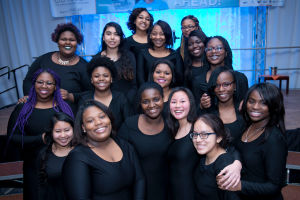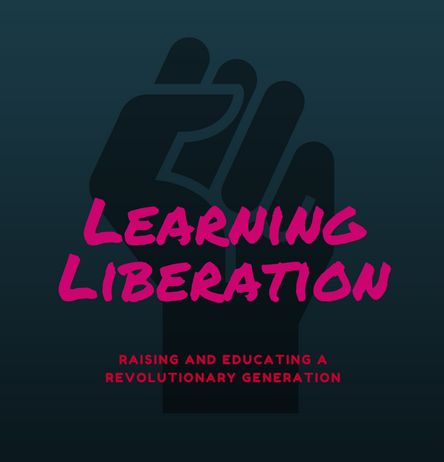Five and a half months ago, I, along with thirty other public education outlets, stood outside Senator Lamar Alexander’s office in my hometown, speaking out against the nomination of Betsy DeVos and the agenda to privatize public education. When she was confirmed as Secretary of Education shortly afterwards, I was once again moved to speak publicly and candidly about what her agenda meant for those of us committed to free and public education for all children. In fact, my commitment to preserving public education as a common good was the reason why I started this blog in the first place.
So it came as a bit of surprise to me — and several of my comrades — when I found myself accepting a teaching job at a (dun-dun-DUUUUUUHN) charter school. And I won’t lie: it was not an easy decision, and I felt a weird kind of guilt about signing that contract. But now that I’ve had to reflect, learn more about the school, and work with my team, I’m ready to talk about why an anti-capitalist, anti-privatization, pro-public school activist might choose to work in a charter school.
But first, some definitions! (Because using unfamiliar terms is a tactic to keep you confused, and I won’t have that.)

A public school is any school that is owned and operated by the local district that educates all children, regardless of their race, income, immigrant status, presence of a disability, sexual/gender identity, religion, or any other factor. Public schools educate students ages 5-18, although students with certain disabilities may start attending as early as age 3 and as late as age 21. Public schools must teach the standards set by their state and collect certain kinds of data on student progress. Types of public schools include neighborhood, magnet, charter, and alternative schools.
Most public schools are neighborhood schools, which are public schools that accept all students living in a set geographic region.
A magnet school is a public school that is owned and run by the school district and has a specific curriculum focus (usually STEM or Fine Arts) that accepts students from all over the district. Students are selected via a lottery system.
An alternative school is a public school specifically for students whose needs cannot be met by their neighborhood school. Students are typically ordered to attend these schools for disciplinary reasons, although alternative schools are also in place for students with severe cognitive disabilities.
A charter school is owned and operated by an outside organization, but is usually held to the laws, standards, and testing requirements of the district. The district has to approve the school’s plans (the “charter”) and has the power to close the school if it fails to meet its obligations. Most charters are run by a voluntary board and operate on a non-profit basis. Some, however, are for-profit businesses. Charters are not allowed to exclude students on the basis of their demographics.
Vouchers are often lumped in with charter schools, but they’re a whole other thing entirely. A voucher is basically a gift certificate given to a family that they are then allowed to spend on the tuition to a private school. Private schools can exclude students for any reason, including religion, disability status, immigrant status, sexual or gender identity, etc. Private schools are entirely managed by their board and are not subject to any of the same regulations as public schools.
Okay, so now that that’s out of the way…..
Why did I decide to work for a charter when I’ve literally been on the news (and this blog) talking about how bad charters are?
First, I made sure they were non-profit. Some charters operate on a for-profit basis. Those charters are ultimately under the control of a business CEO, not an educator, who “makes deals” with investors, and they all expect to get their money back and then some in return. But they still get the majority of the school’s funding from taxes, which means that eventually, public tax dollars are going into the pockets of a CEO, hedge fund managers, and other capitalists who did nothing to actually educate the kids. Y’all know me well enough to know I’m not workin’ for a school like that! And luckily, my school is non-profit, and spends the budget in ways that directly benefit students and teachers, rather than fundraising or providing a return on investment.
I trust the school’s board of directors. Another thing that mattered to me was that its board be comprised of educators and directly impacted members of the community, not business leaders who would use the board as a way of finagling a contract. I was pleasantly surprised! Board members include the founder of my city’s Farmers Market, the first woman to lead our art museum, a nationally-recognized guidance and career counselor, and the director of nursing at a nearby college. Sometimes they help with school projects, but you can tell they’re not interested in “doing business” with the school. These board members aren’t merely fundraisers, and they’re definitely not investors, they’re partners who attend school events and spend time as mentors for students. Heck, I’m starting to think they might spend more time at the school than the elected county school board members do at their schools.
Everybody knows everybody. There is a level of connection between the non-instructional staff and the students that I have not seen at any other school. When I finished my second interview, the Human Resources director took me on a tour of the school. Despite the fact that she did not teach and her office is away from the classrooms, she knew all the students, and even paused the tour to check with a girl who was agonizing about college – during this conversation, she offered to take her to tour in-state HBCUs. The HR Director, you guys!! After working for years at a non-profit where the directors worked miles away from our students and could only name the few who made for good promotional materials, it’s really exciting to be in a place where everyone keeps their focus on the girls.

And I do mean girls, because it’s an all-girls, majority minority school. Single-gender education can be really powerful, and doubly so when 95% of your students are from ethnic minorities. All of the students attending this school live at the intersections of multiple oppressions, including sexism, racism, classism, xenophobia, and ableism. And the school knows it, and responds with an inclusive, culturally-responsive curriculum and wraparound services like tutoring, counseling, family engagement, and even an in-school bank (and students’ contributions to their accounts are 100% matched by sponsors!). All of this is done in a spirit of supporting girls and their families, not “undoing” or “overcoming” what may have happened in the girls’ lives.
I find that distinction very important, because it’s one of the things that sets my school apart from our neighborhood schools. Our public school has a major bureaucracy problem, with six assistant superintendents and up to five principals in each school, most of whom aren’t even from the area! That creates a huge disconnect between the students and the people in charge of their educations. But my school’s leadership is mostly Black and Southern, and they honor and embrace the girls’ cultural backgrounds. There’s an understanding that we don’t need to change the students so they can achieve – we need to change our instruction. Because of its charter status, the school offers things the girls need that they can’t get through county schools, such as standards-based grading, academic intervention for all students, integrated arts instruction, and content that reflects the girls’ lived experiences, such as essays by Malcom X, novels by Zora Neale Hurston, and Howard Zinn’s Peoples’ History rather than social studies textbooks.
Not only does the school take care of its students, but it takes care of the teachers, too. And it’s not just in the form of higher pay (although our salaries are a little higher than the ones in the county) — it’s in the form of deeply relevant professional development training, a health and wellness program to help us cope with stress, mentoring for new staff and teachers, and supportive accountability. Do the principals have high standards for the teachers? Yes. Yes they do. They’re up front about the fact that working in an inner-city, Title 1 school is really freaking hard, and they expect us to do that extra work. But they give us the tools and support we need to reach and teach our girls. They don’t want to catch us messing up – they want to catch up doing well, and solve our problems if we’re making mistakes. I’ve been yearning for that since my student teaching days.
But the biggest reason I chose this charter school is because it is unlike most charter schools.
 If you look at the worst habits of predatory charter schools, it’s easy to see why I would advocate against them. I got lucky, y’all, and just happened to be invited to interview with a charter that doesn’t do those things! The school maxes out at 350 kids, and they do not accept students from wealthy districts in hopes that it will inflate their test scores. They don’t boost their budgets by accepting challenging students, then kick those same kids out as soon as they misbehave. They don’t stick with a one-size-fits-all curriculum, then pressure out students with disabilities (in fact, most of their students are significantly below grade level in reading and could probably qualify for special ed). Added bonus: the school’s leaders are very clear that they want the best for all public schools.
If you look at the worst habits of predatory charter schools, it’s easy to see why I would advocate against them. I got lucky, y’all, and just happened to be invited to interview with a charter that doesn’t do those things! The school maxes out at 350 kids, and they do not accept students from wealthy districts in hopes that it will inflate their test scores. They don’t boost their budgets by accepting challenging students, then kick those same kids out as soon as they misbehave. They don’t stick with a one-size-fits-all curriculum, then pressure out students with disabilities (in fact, most of their students are significantly below grade level in reading and could probably qualify for special ed). Added bonus: the school’s leaders are very clear that they want the best for all public schools.
And I still want the best for them, too. I want every school to offer a culturally-responsive curriculum, to hire passionate teachers, to provide the services kids need to thrive, to take care of their staff in meaningful ways, and embrace their students’ families. So no matter who signs my paychecks, I’m going to continue fighting for public schools. I’m going to keep speaking up when privatizers try to undermine public education and siphon off tax dollars for their personal financial gain.
I chose A charter school, one where I can be the teacher I’ve always wanted to be, for the students I was meant to serve. But I will never forget the public schools (15 total: 7 that educated me, 8 that I’ve educated in) that brought me here, and I’ll keep fighting so that one day, every kid can go to a public school that’s beyond the wildest dreams of any charter school director.


I know that you are awesome as I have worked with you. I know the school you are in and yes – it is a exception to most Chartee schools. I do however hope that you will be a champion to get Charters to allow union support.
LikeLike
I originally included a paragraph about how badly I’ll miss having union representation, but I try to keep blogs at under 2000 words so I had to cut it. 😦 I’d LOOOOOOOOVE to chat with someone about the union about organizing in a Charter!
LikeLike
NEA Representative Assembly is passing a Policy today on Charter schools.
LikeLike